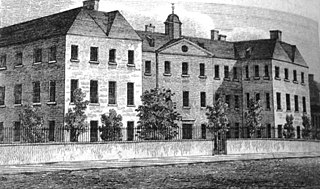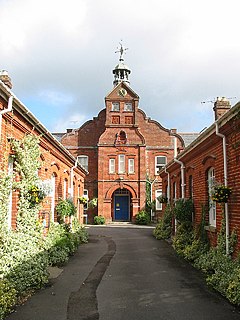
The Town's Hospital was a poorhouse in Glasgow, Scotland, founded in 1731. [1] It occupied a site at the Old Green on Great Clyde Street, at the junction of present-day Ropework Lane. The hospital was managed by the Lord Provost and 48 directors, 12 of whom were elected by the town council. Of the remainder, 12 represented the Church of Scotland's General Session, 12 the merchant's guild and 12 the producer's guild. A year after its opening the Town's Hospital accommodated 61 old people and 90 children. [2]

The Scottish poorhouse, occasionally referred to as a workhouse, provided accommodation for the destitute and poor in Scotland. The term poorhouse was almost invariably used to describe the institutions in that country, as unlike the regime in their workhouse counterparts in neighbouring England and Wales residents were not usually required to labour in return for their upkeep.

Glasgow is the most populous city in Scotland, and the third most populous city in the United Kingdom, as of the 2017 estimated city population of 621,020. Historically part of Lanarkshire, the city now forms the Glasgow City council area, one of the 32 council areas of Scotland; the local authority is Glasgow City Council. Glasgow is situated on the River Clyde in the country's West Central Lowlands. It is the fifth most visited city in the UK.
A Lord Provost is convenor of the local authority, the civic head and the lord-lieutenant of one of the principal cities of Scotland. The role is similar to that of a mayor. Only the cities of Aberdeen, Dundee, Edinburgh and Glasgow have a Lord Provost; other Scottish local authorities have provosts or convenors. Perth previously termed its civil leader a "Lord Provost", but from the Second World War onwards has preferred the simple term Provost of Perth.
Contents
The hospital closed in 1844, although it was reopened briefly in 1848 to house the victims of a cholera outbreak. It was demolished and a warehouse built on the site; [3] its function as a home for the destitute poor of the parish was taken over by the Glasgow City Poorhouse, sometimes also known as the Town's Hospital. Opened in 1845, it occupied premises formerly known as the Glasgow Lunatic Asylum. [2]

Cholera is an infection of the small intestine by some strains of the bacterium Vibrio cholerae. Symptoms may range from none, to mild, to severe. The classic symptom is large amounts of watery diarrhea that lasts a few days. Vomiting and muscle cramps may also occur. Diarrhea can be so severe that it leads within hours to severe dehydration and electrolyte imbalance. This may result in sunken eyes, cold skin, decreased skin elasticity, and wrinkling of the hands and feet. Dehydration can cause the skin to turn bluish. Symptoms start two hours to five days after exposure.














